A crash course on particle physics to get prepared for the steemSTEM meetup at CERN - 1 - the structure of matter
Between 15 and 20 Steemians will soon meet at CERN to visit the place and go down to see, with their own eyes, the CMS detector of the Large Hadron Collider (and the collider itself too). Thanks to Steemit and steemSTEM, the participants to the meetup will hence be able to see, from very close, one of the largest experimental complex ever built by humans.
See here for more information on the meetup.
CMS is represented in the picture below where a human being is also shown for the sake of the comparison. The detector consists in a huge beast of 14000 tons that has a length of 28.7 meters and a diameter of 15 meters. We will be able to see it very closely in 3 weeks. By the way, the ‘C’ in the acronym stands for ‘compact’… The detector is indeed small in size, in particular compared to its brother ATLAS.
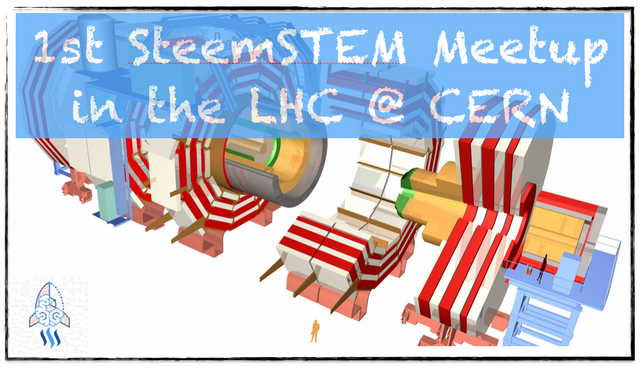
In order to prepare this visit, I decide to start writing a bunch of posts that will explain what we do there, how particle physics works and how the LHC works. I hope this will be useful not only for those attending the meetup, but also for anyone who would like to get some particle physics introduction.
The slides to be presented within a complete presentation at the meetup and that correspond to this post are available here.
THE STRUCTURE OF MATTER
The LHC and the associated experiments aim to probe better the fundamental laws of nature. This means both verifying the Standard Model of particle physics and trying to unravel new phenomena that will demonstrate that the Standard Model has to be extended to some more fundamental theory.
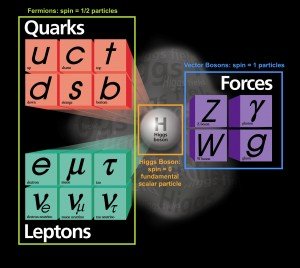
[image credits: Fermilab]
But before explaining how the Standard Model is probed at the LHC (in future posts), I will describe what the Standard Model is.
In one sentence, the Standard Model describes the laws and the properties of the world of the elementary particles, as could be guessed from the above text.
And the elementary particles that we are interested in are those shown in the picture on the left.
In order to describe all these particles, it is good to start from things we all know: an atom.
Since the 1910s (the work of Rutherford), we know that atoms are made of a nucleus, located in a very dense zone at the center of the atom, and of peripheral electrons. Whilst there is no proof that electrons possess a substructure (from indirect measurements of their magnetic moment), there is in contrast observations that atomic nuclei are not fundamental objects.
Those atomic nuclei are indeed all made of neutrons and protons, as discovered during the 20 years that followed the discovery of the atomic structure by Rutherford.
Protons consist in (one of) the stuff that is accelerated, arranged in collimated beams inside the LHC and smashed.
However, the story does not end here. By studying the scattering of electrons from protons and neutrons, it has been found that those particles are also composite objects. The entities making up the protons and the neutrons are called quarks, and we need two species of them to form neutrons and protons: up quarks and down quarks.
All of this is summarized in the below picture.
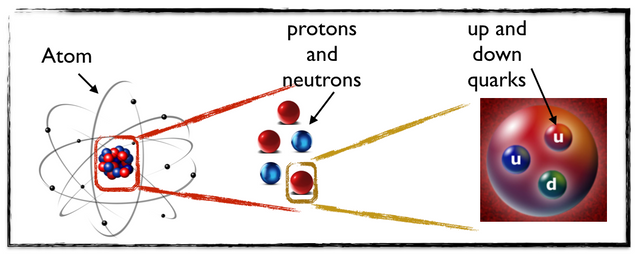
[image credits: homemade (from stuff available everywhere)]
One can notice in the picture that the proton is shown as made of two up quarks and one down quark. That is of course a too simplistic picture for what concerns the LHC. But this is for the next posts, when I will discuss LHC collisions. In short, we can say that the proton is in reality some very complex stuff.
Although we may want to go deep inside the quarks, there is currently no experimental sign of a quark substructure. We can thus stop here.
We have so far introduced three fundamental particles that explain how matter is made of: the up and down quarks, and the electron.
NEUTRINOS
So far, we have met three particles. But there is actually a fourth important fundamental guy, the neutrino. Its existence was unravelled in the study f radioactive beta decays at the beginning of the 20th century.
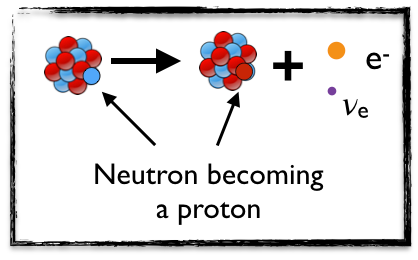
[image credits: homemade]
The neutrino was postulated (and then discovered) in order to explain the corresponding data. The beta decay mechanism, at the atomic level, is summarized on the right.
The represented atomic nucleus sees one of his constituting protons becoming a neutron, which happens together with the emission for an electron and a neutrino.
Without the neutrino, the energy of the electron has to be equal to a single well-defined value E. When studying data, the energy can however take a lot of values, ranging from 0 to E. The presence of the neutrino allows this, the available energy being then shared between the electron and the neutrino.
We have thus four elementary particles: the up quark, the down quark, the electron and the neutrino. This is what is called the first generation of elementary fermions.
BEYOND THE STRUCTURE OF MATTER: THE NUMBER 3
One concept is important in the last sentence above: the wording first generation. This means we have other generations of fermions. Nature was nice enough to make two extra copies of these 4 particles (the up and down quarks, the electron and the (actually electronic) neutrino), so that we end up with 12 elementary fermions.
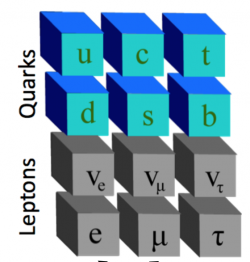
[image credits: unknown (everywhere on the web)]
Those 12 guys are shown on the left. We have three up-type quarks (up, charm and top), three down-type quarks (down, strange and bottom), three charged leptons (electron, muon and tau) and three neutrinos. In addition, all of these guys come with their own antiparticle.
The only difference between the properties of the particles in two different columns consists of their mass. The second column is heavier than the first one, and the third column is heavier than the second one. The rest is identical.
Why three? Well, if you know, you may get the Nobel prize. This is question a good bunch of researchers are trying to answer today. This is something on which I have never personally worked.
The only certainty of today is that we have three of such copies in total. Not four. Not two. We can however have other fermions. But those must have different properties when compared to the Standard Model fermions.
SUMMARY
I started a series of post preparing the meetup, in order to get well prepared to what will be seen. In this post, I started to describe the Standard Model of particle physics and focus on the structure of matter, showing how the connection between the 12 elementary fermions and atoms work.
The slides that I will present during my presentation at the meetup are available here.
More information can also be found in many textbooks. For non-specialists, I recommend this one, from the Nobel prize winner M. Veltman.
SteemSTEM
SteemSTEM is a community-driven project that now runs on Steemit for more than a year. We seek to build a community of science lovers on Steemit and to promote well written/informative Science Technology Engineering and Mathematics (STEM) postings in order to make Steemit a place for fascinating STEM content.
More information can be found on the @steemstem blog, on Discord and on the Steemit chat.
well, at least I understand what I am missing so far.
Cool! That is one of the goal of this series: making what is going on comprehensive for non physicists :)
I have got a little background in chemistry and math (LK an der Schule und ein-zwei Semester an der Uni :D), so this is not an all too frightening area of science to me. So far we got 2 quarks forming neutrons and protons, 1 neutrino that is created in a specific form of radioactive decay and the good old familar electron. All four of them in 3 different weight classes, so far so good, when do we start with the hard stuff? :P
In my next post (in a couple of days, probably), I will start discussing how those guys interact with each other and what are gauge symmetries (in a couple of words, no fancy details). And of course, I may introduce the Higgs. Depending on how long the post get (I try not to be above 1500 words), the Higgs may be left over for a third post.
Do the particles in the same column have the same mass btw?
No, all masses are different. Excepted neutrinos, each mass is a free parameter of the model that has to be tuned according to measurements. They have all been found different. In the Standard Model, neutrinos are massless. This contradicts data. You can check my answer to the comment of @nonationnoborder for more information with this respect.
It's so interesting, I wish I could come!!! This is one of my dream to visit the LHC!
Maybe the next time. There will be extra options to go down into the LHC in 2019-2020, when the macihine will be shutdown for a long time for major upgrades. But I don't know whether I will organize a second meetup inside it. Maybe yes, maybe not. The future will tell ^^
I guess the outcome of the first meeting will tell! It's a fantastic initiative from you to organise such a visit. Thank you, I hope you will do it again in the future!
I will try, if there is an interest :)
Surprising that you haven't commented on the neutrino-mass inconsistency within the standard model. Is it possible if you make a post on this in the near future? :D
No, because I already did here :D
This is the link you get if you click on radiative beta decay ;)
Read it, wouldn't this mean that a revision of the standard model should still take place? :) thanks for the information
There are many models incorporating neutrino masses. However, they do not only incorporate neutrino masses, but also many other things that have not been discovered (yet?). Therefore, for the moment, we do not know how to exactly extent the Standard Model to add the neutrino masses. We know they must be there, but we do not know how (yet? :p ).
Thank you for clarifying :D
My pleasure! :)
Sir, there's really something that confuses me about these particles.
Are positrons fermions? You didn't quite mention positron in the post, but I'm just being curious.
Thanks you sir
Positrons are there. I have here focus on the particles, but each of those has an antimatter counterpart. I have added a line in the post. Thanks for your comment!
Thanks a lot sir for your kind response. I'm really grateful
:)
Really nice introduction. I have heard about the generations in particle physics but first time I am understanding the subject matter.
Many thanks XD
My pleasure. Glad to read you liked it ^^
"A crash course on particle physics" haha
omg you got lecture notes on that XDD
:)
Of course! :D
I love this!!! This was easy to understand yet did not go extremely in depth. looking forward to reading the rest of the post on this event it sounds very interesting.
He makes it appear easy :)
Thanks for the comment!
I will need some time to cook it up... I don't even know exactly what I will and won't cover, to be honest. I only know I have 3 weeks :D
Arggghh I'm so envious and pissed I'm not being able to attend this SteemSTEM meetup!!! That too at the CERN OMG!!! Physics was one of my very strong subjects at A levels and I used to drive my teachers crazy with my extra curiosity about nuclear physics!!!
I wish you guys have a great time!!
Sorry to read that. Maybe, as I said to @delph-in-holland, I could organize a second one next year and you will hopefully be able to come ^^
I definitely hope so!! xD xD
The future will tell us :)
I'd love to see the LHC. Read so much about it. Seeing it life would make my day. But at the moment I can only wish.
Other opportunities will be possible, you can count on me!
I like the sound of that.
That for scale tiny human has got me so friggin excited! Compact indeed - this is gonna be awesome. I will lilely purchase the non-textbook you recommended. I think I'm generally familiar, as far as a layman is concerned, but the more informed I am the more enjoyable the tour is bound to be.
I never had the chance to give a particle physics introduction to bachelor students, but this is definitely the textbook I would recommend them to check. ATLAS is much larger, and we see it from much closer (so that at the end of the day, it is less impressive than CMS, IMO). We will have fun!
Thanks, looking forward to collision post!
You will have to be patient. This is for In 3 or 4 posts I guess :)